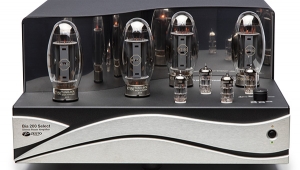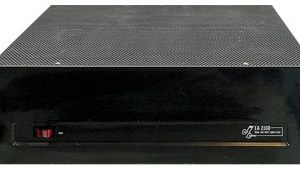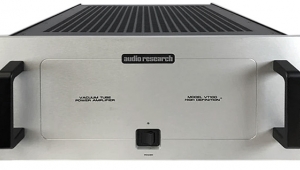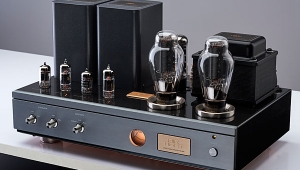| Columns Retired Columns & Blogs |
Berning EA-2101 power amplifier Page 2
But nothing is without its price. Because the screen grid is farther away from the cathode than the control grid, it is much less effective in controlling plate current. A 300V drive signal is required for the screen grid to take control, meaning that you end up with another amplifier just to drive the output stage. A total of four Russian-made 6SN7 dual-triodes per channel generate the requisite voltage gain. All of the gain stages are fully balanced, and the inputs accept either XLR balanced cable or unbalanced RCA terminations. A switch on the back of the amp allows changeover from balanced to unbalanced connection.
Continuing a Berning tradition, a minimal amount of negative feedback is used, much of it local in the form of unbypassed cathode resistors. A short feedback loop from the output stage to the second gain stage reduces overall gain and the output impedance, though the latter remains fairly high. Teflon circuit boards are used in preference to the standard glass epoxy type.
The secondary of the output transformer is sectioned into four isolated windings. These may be connected in a variety of series or series-parallel configurations to provide better coupling to the load than can normally be achieved with the standard tapped winding.
Loudspeaker connections at the rear of the amp are a bit intimidating, therefore. A terminal strip is provided for each channel, with a pair of flying leads as well as a pair of conventional (though of forgettable quality) binding posts. At the factory, the windings are connected in series with jumpers that join terminals 2 through 7. The black flying lead is connected to terminal 1, which is grounded; the red flying lead may be connected to terminals 2 or 3 for a matching impedance of 0.89 ohms, terminals 4 or 5 for a matching impedance of 3.55 ohms, terminals 6 or 7 for an impedance of 8.0 ohms, and terminal 8 for an impedance of 14.22 ohms. Speaker connections may be made either at the terminal strip or, for convenience, at the binding posts. Since the four secondary windings are independent, by removing the jumpers it's possible to place them in parallel to obtain a high-current 0.89 ohm output. Another possibility is a series-parallel connection, to arrive at a high-current 3.55 ohm output. Even so, the peak current capability of a tube amplifier is not in the league of solid-state designs; I wouldn't consider using a tube amp to drive something like an Apogee. With the speaker loads I had on hand, I ended up using the 8 and 14.22 ohm outputs exclusively.
Beware the duck—and DO!
Another Berning trademark is the use of a resonant-type switching power supply. Not only are all of the tube heaters provided with a regulated DC supply, but, most unusually, the main 700V plate supply is also regulated. There are also a number of interesting safety features incorporated into the design. The power supply goes through a "soft-start" turn-on sequence that reduces the initial power surge. Main current draw is delayed by about one second after the power switch is fully closed.
But beware the duck—a bleep from the power supply immediately after turn-on sounds like a duck being fried inside. Dave assured me that the sound is perfectly normal, and indicates that the soft-start circuit is working.
The power supply, smart enough to sense low-line voltage conditions, will not turn on if the mains voltage is less than 80% of nominal. Should a brown-out occur during use, the amp will shut off provided the line voltage drops to a sustained level below nominal. The current through each tube is monitored. Any circuit fault or tube failure that results in dangerously high current causes the power supply to be placed in a fold-back current-limit mode that protects the burning out of vulnerable circuit components. However, high power-supply current associated with amplifier clipping does not trigger the current limitation mode, as that would obviously be bad sonically.
Based on the foregoing, you'd think this amp was bulletproof, but DO found a way to take one channel out of commission. Apparently there's now a warning appended to the manual about this, so there's no excuse for you to do what I did. Do not make or break input connections with the amp powered on—especially with no load connected. The latter condition is especially bad, and describes accurately what I did. This causes the output stage to oscillate and do nasty things to the circuit. Dave graciously repaired the damage; as for me, I've been careful not to repeat the scenario.
The amp is rebiased at the factory after one week of burn-in. Because most component aging occurs during this period, further drifting of the bias should be insignificant. That's good news—adjusting the bias is not all that easy, and requires removal of the top cover in order to tweak the bias pots. These pots are fairly close to the output tubes, but since the latter run fairly cool, this procedure does not require asbestos fingers. However, just measuring the bias is easier, and can be done through holes provided on the bottom of the chassis. These holes allow test leads to access the 15 ohm bias-drop resistors and verify a 100mV voltage drop. Berning recommends rebiasing the amp after the first two years of use, and every five years thereafter. Just for the hell of it, I decided to check and tweak the bias. The bias as measured across the resistors was within 5mV of 100mV, and although that's not a significant deviation, I tweaked the voltage to within 1mV.
As far as looks are concerned, the EA-2101's somewhat industrial look is compensated for by the front-panel window. The red window gives you a panoramic sunset view of the output stage in full glow. That alone is worth a few points in my book.
- Log in or register to post comments



































